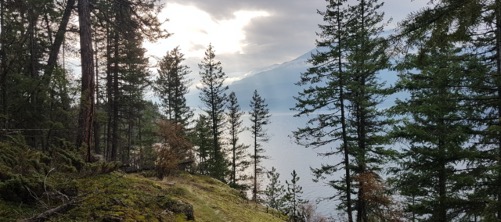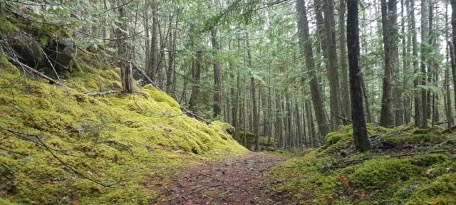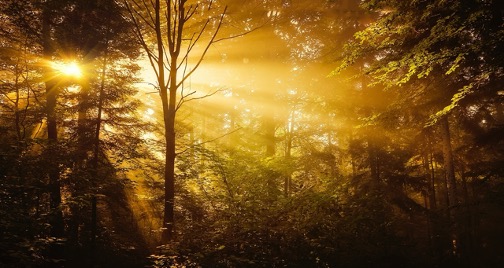Part II, Holy Week 2021, Easter Sunday
I throw open the gate to rushing wind and creaking branches. Not knowing what lays ahead, I step into the forest with my companions, fear, awe, and more hesitantly, joy.
Like many, perhaps even like Mary Magdalene, I have found myself increasingly worn by heavy times. A veil of uneasiness and loss had shrouded me. I dared to hope that I could free myself of chafing isolation, stand again in the forest’s open arms, and remember the hidden flow of bright, expectant trust.
So I headed to the mountains of southeastern British Columbia, near where I grew up, for a month alone in a woodland cabin. A privilege to sit on a mountain’s shoulder when people everywhere have clamored for mobility and space. Around me towered the Selkirk and Purcell ranges and before me lay the deep, dark waters of Kootenay Lake. This enormous land and its formidable inhabitants—eagles, cougars, grizzlies—reminded me of my childhood perspective on humanity. Rising cliffs and glaciers, still black water, impenetrable forest all show up our smallness.
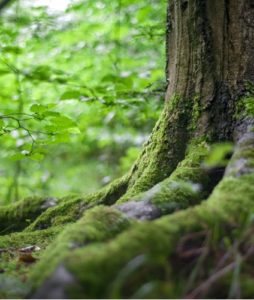 I learned as a child in the mountains how the smallness of everything creates the great whole, woven together by the Divine’s glistening web. Now I sought to remember that panoramic vision and wait with patience for the Beloved who connects us.
I learned as a child in the mountains how the smallness of everything creates the great whole, woven together by the Divine’s glistening web. Now I sought to remember that panoramic vision and wait with patience for the Beloved who connects us.
Beneath the forest’s cloak, I crafted my days as do the monks with whom I have studied: my own version of a Benedictine rhythm of ora et labora, or prayer and work. My prayer stool sat before a makeshift windowsill altar, adorned with incense, candles, and an icon of Christ Pantokrator, and also an increasing collection of treasures: scaly bark, jewel-toned lake pebbles, lichen, feathers, and marbled fragments from a wasp nest. Like steadfast friends who together watch and wait, they accompanied me in pondering ribbons of pearly light on branches, water, and peaks.
There I prayed and meditated four times a day. In between I cooked, washed dishes, read, and wrote. Mostly I walked.
Using ears and eyes and heart in that extended silence and stillness, I sought to attune my senses to the Divine as I stepped along the path. I listened intently and something began to take shape. Over my hours and hours walking through that ocean of trees, something magical emerged. Magical and completely ordinary.
I began to sense the flowing undercurrent of the Divine, and I began to find my courage. Courage to keep my vigil in the face of absence and death and uncertainty. Courage to trust the age-old wisdom that all shall be well.
I had not noticed before that ‘courage’ is very like the word ‘cougar.’ Each day I headed out into the temperate rainforest with cougars and bears hiddhttp://duversity.us-east-2.elasticbeanstalk.com/moodle/my/en around me. Their tracks told the tale, leaving no doubt about my vulnerability. I cannot say that they did not inspire fear. As I hiked, I found myself stopping and listening, scanning the forest for movement and sound: the flute-like warble of a Varied Thrush, a chipmunk’s chittering, the rare thrum of distant noontime avalanches, a waterfall’s roar, the ratatat of Western Flickers foraging in the larch.
Still, I ventured deeper.
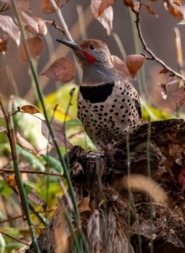 Before I left the city, I knew that spending time in solitude in such a powerful landscape might cause old darknesses to rise in me. As a young girl, when I felt threatened by the creeping mist of uncertain others, I learned to ask for God’s protection by invoking a circle of light around myself. I hadn’t called on that Divine circle of light in a great long time. I had forgotten. Now seemed like a good time to try again.
Before I left the city, I knew that spending time in solitude in such a powerful landscape might cause old darknesses to rise in me. As a young girl, when I felt threatened by the creeping mist of uncertain others, I learned to ask for God’s protection by invoking a circle of light around myself. I hadn’t called on that Divine circle of light in a great long time. I had forgotten. Now seemed like a good time to try again.
But as an adult with greater experience and knowledge, a defensive desire for self-preservation seems too much like a refusal to love. Can we be sent forth to love and serve if we recoil and fence ourselves in? Maybe that circle of light could transform from a tool of resistance and exclusion to a field of receptivity and welcome. Could I imagine receiving a bear or cougar with love? Could I see them as my neighbours?
This is when I sensed a shift. Choosing to stand vulnerable and open despite fear, I was surprised to find the stone cast aside and the tomb empty.
Before me, on the ragged juniper-edged trail, lay the remains of a freshly killed deer. My adrenaline rose and my heart raced, alert for the territorial hunter. But there was only silence. There she lay with gentle unseeing eyes and fur the colour of linen. Her twisted flesh and sinew lay scattered and torn like a shroud shaken off and flung into a corner. Red cedar sentries stood nearby, with angel hair lichen and glowing robes of chartreuse moss.
“Why do you look for the living among the dead?” they whispered.
Shafts of light pierced the forest canopy. I sensed the Beloved rise.
With a mixture of fear and joy, I turned quickly to retrace the overgrown path. Certainly, an aggressor could be at hand; there was a chance that I could be hurt. But I had chosen, with God’s help, not to let that control me. Like Mary Magdalene unsure and frightened at the mouth of an empty tomb. The Gardener calls her by name, and only then she understands and sees. Mary Magdalene takes her awesome fear and runs with it, full of vibrancy and joy, to tell the world that He is come.
‘Yes!’ is the only possible answer.
How dense the forest is, how alive with trundling beetles, emerald ferns, and cliffside hemlocks risking themselves to eye the sparkling lake. The mountain lion spreads herself languorously, keeping watch atop a verdant, mossy boulder.
How splendid and how terrifying is the transformation of death to life.
The Beloved radiates his field of love, generosity, and peace. We dare to trust, and find that absence transforms to presence and fear transforms to joy. Should we be surprised by the dissolution of fear?
Easter 2021
Vancouver, BC
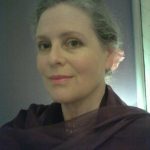 This is Part II of a Holy Week reflection provided by Paula Pryce from Vancouver, Canada. You will find Part I, Absence: Forest of Longing posted in the Forum on Good Friday.
This is Part II of a Holy Week reflection provided by Paula Pryce from Vancouver, Canada. You will find Part I, Absence: Forest of Longing posted in the Forum on Good Friday.
Paula serves on the board of our sister ship The Contemplative Society where you will also find Paula’s writing (thank you Eilen!). Other contributions to Northeast Wisdom / Wisdom Waypoints include No Question: A Pilgrimage to India with Rev. Matthew Wright and Br. Aidan Owen, OHC on the home page blog and Living Waters and COVID-19 on the Forum. Learn more about Paula Pryce on her Faces of Wisdom Profile here.
Paula Pryce is a cultural anthropologist and writer at The University of British Columbia who studies contemplative religions and ritual aesthetics. She is the author of The Monk’s Cell, for which, in part, she followed Cynthia Bourgeault and members of our Wisdom community. It is available from Oxford University Press for a 30% discount with promotional code AAFLYG6 entered and applied on your shopping cart. The Press says about the book:
The call to contemplative Christianity is not an easy one. Those who answer it set themselves to the arduous task of self-reformation through rigorous study and practice… Those who are dedicated can spend hours every day in meditation, prayer, liturgy, and study. Why do they come? Indeed, how do they find their way to the door at all?
Based on nearly four years of research among semi-cloistered Christian monastics and a dispersed network of non-monastic Christian contemplatives across the United States and around the globe… Organized by the metaphor of a seeker journeying towards the inner chambers of a monastic chapel, The Monk’s Cell uses innovative “intersubjective fieldwork” methods… to show how practices like solitude, chant, contemplation, attention, and a paradoxical capacity to combine ritual with intentional “unknowing” develop and hone a powerful sense of communion with the world.
Images from the top: Kootenay Lake Forest, image courtesy of artist Paula Pryce; Green Tree Near Green Plants, image courtesy of artist mali maeder, Pexels; Western Flicker, courtesy of artist Frank Cone, Pexels; Kootenay Mossy Path, photo courtesy of Paula Pryce; Morning Light Trees in the Forest, image courtesy of artist Ray Bilcliff, Pexels.


